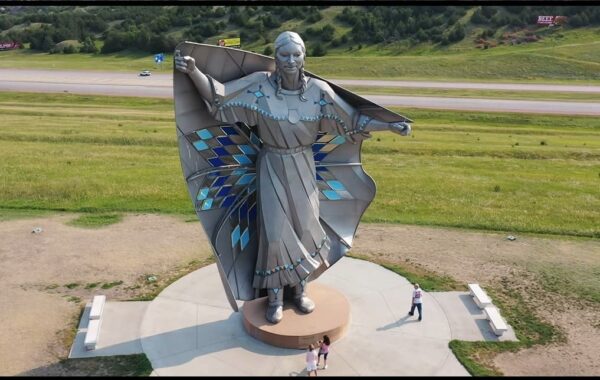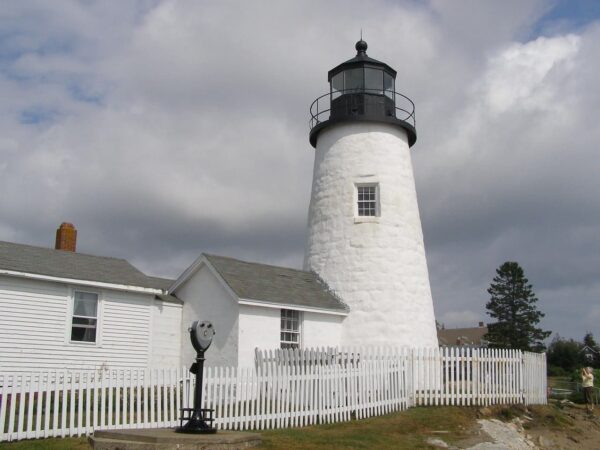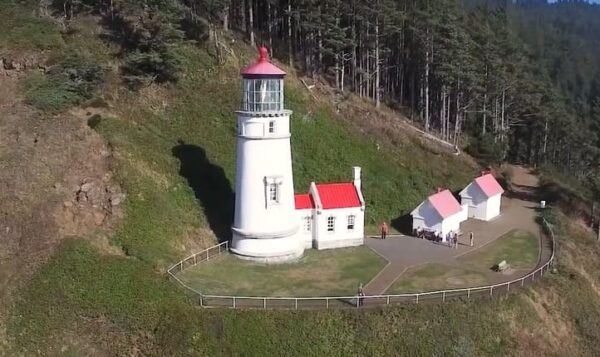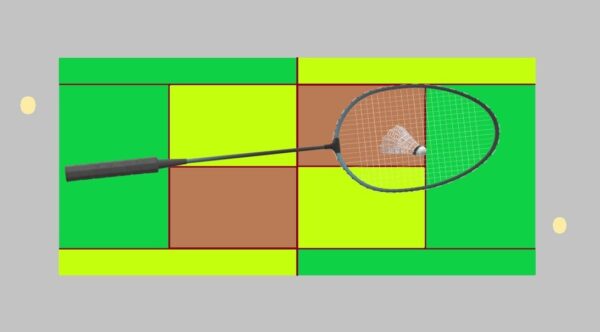15 Famous things that are 50 feet long

If you want to know how long is 50 feet and the famous things that are approximately fifty feet long or tall, then this article is for you. There are many famous landmarks, statues, and natural wonders around the world that are either 50 feet tall or long. These structures are often symbols of culture, history, and nature, leaving a lasting impression on those who see them.
50 feet is not a frequent length for constructions or objects, but it does exist in certain things that are slightly longer or shorter than 50 feet, but it still provides a useful comparison. These 50-foot tall or long famous structures and landmarks highlight human achievement, natural wonder, and history. Whether they are statues, trees, or buildings, each of these monumental features has a unique story to tell.
How long is 50 feet visually?
Understanding measurements and sizes can often be a challenge, especially when to visualizing specific lengths. Fifty feet is a measurement that can be challenging if you don’t have a reference point. However, by comparing it to everyday objects and familiar spaces, we can create a mental image of just how long fifty feet really is.
One of the best ways to visualize 50 feet is to imagine or compared to everyday objects and measurements to give you a better sense of its size. These comparisons should help you visualize the length of 50 feet more clearly.
Visualizing 50 feet may initially seem tricky, but by using everyday objects and experiences, it becomes much easier. Many famous things around the world stand or stretch to about fifty feet in height or length, capturing our imagination and symbolizing human achievement or nature’s power.
How far is 50 feet when walking?
Walking 50 feet is quick and easy, it can be helpful to understand how it feels in terms of steps and time. It’s a relatively short distance and in terms of time, it would take roughly 10 to 15 seconds to walk that distance, depending on your walking pace.
The average person’s stride length is about 2.5 feet, so it would take about 20 steps to cover 50 feet. To visualize it, imagine half the length of a standard basketball court (which is 94 feet) or about 1.5 school buses parked end to end (a typical school bus is around 35-40 feet long).
15 Things That Measure 50 Feet
Here are a few iconic examples of things that are approximately 50 feet tall or long, ranging from natural wonders to man-made structures and objects.
- Stretch Limousine
- The Dignity: Of Earth & Sky
- The Black Hawk Statue
- Peggy’s Point Lighthouse
- Basketball Court Width
- Blue Whales (Newborns)
- Beechcraft King Air 350
- PCC car 451
- Statue of Liberty’s torch holding Arm
- The Split Rock Lighthouse
- Bass Harbor Head Lighthouse
- Heceta Head Lighthouse
- Hollywood Sign Letters
- Blue Angels Aircraft (F/A-18 Hornet)
- The Badminton Court
Stretch Limousine

Limousines are most commonly stretch vehicles, meaning they have been extended to provide extra length. This can range from just a few feet longer than a standard car to more extreme versions, like stretch limousines that can be as long as 30-50 feet (9-15 meters) or more.
A stretch limousine is a luxurious, elongated vehicle designed for comfort, style, and exclusivity. These are typically used for high-end events such as weddings, proms, corporate events, or celebrity appearances.
There are several stretch limos that can reach around 50 feet in length, offering luxury features like plush seating, sound systems, mini-bars, and even disco lights. A 50 feet limo is often built to the specifications of a wealthy client or for promotional purposes.
A typical stretch limo might be 20-30 feet long, but for special events, particularly in the entertainment industry, the demand for larger limos has led to these 50-foot designs.
The reason limousines get stretched out to extreme lengths is for the sake of luxury and the ability to accommodate more passengers.
The Dignity: Of Earth & Sky

The Dignity: Of Earth & Sky is a striking and iconic sculpture located in South Dakota, USA. It is a monumental statue that celebrates the culture and heritage of Native Americans, particularly the Lakota and Dakota tribes. The sculpture faces the Missouri River, a significant waterway for Native American tribes. The upward-facing gaze of the woman in the statue is seen as a sign of respect and connection to the heavens, representing spiritual transcendence.
This stainless steel sculpture was created by artist Dale Lamphere to honor the cultures of the Lakota and Dakota people. It is a stunning tribute, with the figure of a Native American woman holding a star quilt, symbolizing strength, grace, and the beauty of the native cultures.
The statue is a 50 feet tall stainless steel sculpture, which reflects sunlight during the day and can be illuminated at night. The star blanket features blue diamond shapes made of dichroic glass, which changes color depending on the angle of the light. At night, the statue is illuminated with LED lights, creating a stunning visual effect.
The sculpture was dedicated in 2016 as part of the state’s efforts to celebrate Native American culture and history in South Dakota. The statue was a gift to the state of South Dakota from philanthropists Norm and Eunabel McKie. The sculpture has become a symbol of pride for both Native Americans and South Dakotans.
The Black Hawk Statue

The Black Hawk Statue, also known as “The Eternal Indian”, is an iconic and historic monument located in Lowden State Park near Oregon, Illinois in the USA. This striking monument is one of the most recognizable landmarks in the region and a tribute to honoring Black Hawk, a prominent Native American leader of the Sauk tribe.
The statue was inspired by Black Hawk, a prominent leader of the Sauk tribe who led a resistance against U.S. forces during the Black Hawk War of 1832. Although the war ended in defeat for the Sauk, Black Hawk became a symbol of Native American resilience and pride.
The statue was created by Lorado Taft and it stands at an impressive 48 feet tall (close to 50 feet tall) overlooking the Rock River, making it one of the largest sculptures of its kind.
On November 5, 2009, the Black Hawk Statue was added to the U.S. National Register of Historic Places. It is a popular site for both tourists and locals who want to learn about the history of the area.
If you ever get a chance to visit, it’s definitely a piece of history worth seeing!
Address: Lowden State Park, 1411 N River Rd, Oregon, IL 61061, USA.
Peggy’s Point Lighthouse

One of Canada’s most famous and well-liked tourist destinations is the Peggy’s Point Lighthouse, which is situated in the tiny fishing village of Peggy’s Cove, Nova Scotia. Another name for it is Peggy’s Cove Lighthouse.
The lighthouse stands on a rugged granite outcrop overlooking the Atlantic Ocean, which is part of the Peggy’s Cove landscape, offering stunning views of the coastline. The lighthouse and its surroundings have inspired countless artists, writers, and photographers.
Peggy’s Point Lighthouse (Peggy’s Cove Lighthouse) is 49 feet tall (approximately 50 feet) from its base to the top of the tower. The structure itself has a relatively simple cylindrical design, with a wide, white tower topped by a red lantern room.
Peggy’s Point Lighthouse is one of the most visited lighthouses in Canada, attracting thousands of tourists annually. The lighthouse is a symbol of Nova Scotia’s maritime history and has been featured in numerous films, TV shows, and postcards.
Basketball Court Width

Basketball is one of the most popular sports in the world, with millions of players and fans. It is known for its fast pace, high scoring, and exciting moments, such as slam dunks and three-point shots. The game is typically played on a rectangular court with a hoop (a netted structure called a “basket”) at each end.
The width of a standard basketball court to both NBA and NCAA courts is 50 feet however, for FIBA (international) courts, the width is slightly smaller at 49.21 feet. The NBA, NCAA are two of the most prominent organizations in basketball and FIBA (Fédération Internationale de Basketball) is the international governing body for basketball.
The overall dimensions of a standard basketball court vary slightly depending on the level of play (e.g., NBA, NCAA, FIBA), but here are the general measurements for a standard basketball court:
Dimensions of a Standard Basketball Court
- Length:
- NCAA: 94 feet (28.65 meters) for men, 84 feet (25.6 meters) for women.
- NBA: 94 feet (28.65 meters).
- FIBA: 91.86 feet (28 meters).
- Width:
- NBA: 50 feet (15.24 meters).
- NCAA: 50 feet (15.24 meters).
- FIBA: 49.21 feet (15 meters)
Blue Whales (Newborns)

Blue whales are marine mammals. They are the largest mammals that have ever lived on Earth, outweighing even the largest dinosaurs. They are typically bluish-gray, which gives them their name.
Adult blue whales can grow to be more than 100 feet long. Despite their massive size, blue whales primarily feed on tiny creatures called krill, which are small shrimp-like animals. They can consume up to 4 tons of krill per day during feeding seasons.
Blue whales are found in all the world’s oceans, from the Arctic to the Antarctic, though they prefer colder waters for feeding and warmer waters for breeding and calving. Blue whales have a long gestation period of about 10-12 months. Females typically give birth to a single calf, which will nurse on rich, fatty milk for about a year.
Newborn blue whales are among the largest babies in the animal kingdom. At birth, a blue whale calf is about 23 to 26 feet long. Blue whale calves grow incredibly fast, gaining about 200 pounds (90 kilograms) per day during their first year. This is due to their mother’s rich milk, which is about 40-50% fat.
Calves are typically weaned at around 6 to 8 months old, by which time they can reach lengths of about 50 feet (15 meters). After weaning, they begin to eat small crustaceans called krill, consuming up to 4 tons (8,000 pounds) of krill per day as adults.
Beechcraft King Air 350

The Beechcraft King Air 350 is a versatile and reliable aircraft that has earned its place as a workhorse in both civilian and military aviation. This is a popular twin-turboprop aircraft manufactured by Textron Aviation.
The King Air 350 is widely used for both commercial and private purposes, including passenger transport, air ambulance services, cargo, and more. It is one of the best-selling turboprop aircraft in its class, with hundreds of units delivered worldwide. It’s known for its comfortable cabin and impressive performance.
The King Air 350 has a length of 46 feet 8 inches which is just a few feet short to 50 feet. Most airplanes around this length are smaller, general aviation or regional aircraft, though some larger jets also fall in this range.
The Beechcraft King Air 350 has the following overall dimensions:
- Length: 46.8 feet
- Wingspan: 57.9 feet
- Height: 14.4 feet
PCC car 451

Illinois Terminal Railroad’s Presidents’ Conference Committee (PCC) car 451 is a unique piece of railroad history. This particular car is part of the Presidents’ Conference Committee (PCC) fleet, which was a group of streetcars built in the mid-20th century for use in urban transit systems across the United States.
Car 451 is one of the PCC streetcars that were operated by the Illinois Terminal Railroad. The PCC cars were known for their sleek, streamlined design, smooth acceleration, and quiet operation, which made them popular with both passengers and transit operators.
In the 1930s a group of electric railway operations and manufacturers, the “PCC”, created a set of specifications for modernized, safer, and more comfortable streetcars No. 451 is one of these cars.
Built by the St. Louis Car Company and operated by the Illinois Terminal Railroad from 1949 to 1958, the PCC cars ran on a 6.3-mile line between Granite City, IL, and St. Louis, MO. When they were no longer needed, Shaker Heights Rapid Transit near Cleveland, OH, considered buying them but most had been water-damaged due to flooding and they were put into storage. In 1963 the Cleveland RTA also declined to purchase them, and NO. 451 was acquired by the Connecticut Trolley Museum in 1966.
Here are the typical dimensions for a PCC streetcar:
- Length: Approximately 46 feet (14 meters).
- Width: Approximately 8 feet 4 inches (2.54 meters).
- Height: Approximately 10 feet (3.05 meters) (including the roof and equipment).
This car is currently a part of the collection at the Connecticut Trolley Museum in Windsor Locks CT.
Statue of Liberty’s torch holding Arm

The total length of the Statue of Liberty’s arm, including the torch, is approximately 46 feet (just 4 feet short to 50 feet). The arm is extended upward and slightly forward, holding the torch high as a symbol of liberty and enlightenment.
The arm itself, which is about 42 feet long from the shoulder to the tip of the torch. The torch, which adds an additional 29 feet in height above the base of the arm. However, since the torch is held at an angle, the total length of the arm and torch combined is roughly 46 feet when measured along the axis of the arm.
The Statue of Liberty’s arm and torch are iconic elements of the statue, contributing to its overall height of 305 feet from the base to the tip of the torch. The torch was redesigned and replaced during the statue’s restoration in 1986, and the original torch is now on display in the Statue of Liberty Museum on Liberty Island.
The Statue of Liberty is a gift of friendship from the people of France to the United States.
The Split Rock Lighthouse

The Split Rock Lighthouse is a historic landmark on Lake Superior’s North Shore in Minnesota, USA. This Lighthouse is one of the most photographed lighthouses in the United States and is considered an iconic symbol of Minnesota. It was listed on the National Register of Historic Places in 1969 and designated as a National Historic Landmark in 2011.
The lighthouse was built in 1910 by the United States Lighthouse Service to guide ships safely through the lake’s dangerous water, particularly during the stormy season. It was first lit on July 31, 1910, and served as a crucial navigational aid for ships traveling on Lake Superior. The lighthouse was decommissioned in 1969 when modern navigational technology made it obsolete.
The lighthouse features a cylindrical tower made of brick and concrete, standing 54 feet tall just a few feet more than 50 feet. The attached lightkeeper’s house and other outbuildings are constructed in the Arts and Crafts style. Visitors can tour the lighthouse, climb to the top of the tower, and explore the keeper’s house, which has been restored to reflect the early 20th-century living conditions.
The Split Rock Lighthouse is a beautiful and historic place to visit for anyone interested in maritime history, scenic landscapes, or just enjoying the beauty of Minnesota’s North Shore.
Bass Harbor Head Lighthouse

The Bass Harbor Head Lighthouse is a historic lighthouse located on Mount Desert Island in Maine, USA. It is situated within Acadia National Park, near the village of Bass Harbor. It’s one of the most iconic lighthouses in the region, known for its scenic beauty and its striking red-and-white color scheme.
The lighthouse was built in 1858 by the United States Lighthouse Service to aid navigation in the Bass Harbor and Blue Hill Bay areas. The lighthouse features a classic New England design with a white, cylindrical tower made of brick and the attached lightkeeper’s house is a one-and-a-half-story wooden structure.
The Bass Harbor Head Lighthouse itself is a relatively small structure. The lighthouse tower stands 32 feet tall. However the total length of the entire structure, including the attached lightkeeper’s house, the building is approximately 46 feet long almost close to 50 feet. It was listed on the National Register of Historic Places in 1988, recognizing its historical and architectural significance.
The lighthouse is an iconic symbol of the Maine coast and is often featured in travel guides, postcards, and promotional materials for the state. While the lighthouse itself is not open to the public, the grounds are accessible, and visitors can enjoy scenic views of the lighthouse and the surrounding coastline.
Heceta Head Lighthouse

The Heceta Head lighthouse was constructed in 1894 and was named after the Spanish explorer Bruno de Heceta, who explored the Pacific Northwest in the 18th century. This is one of Oregon’s most famous and picturesque lighthouses, located along the stunning coastline near Florence, Oregon.
The lighthouse tower itself is 56 feet tall, with a white and red color scheme, which is quite striking against the green landscape. The lighthouse stands 56 feet tall, but due to its elevated position on the headland, the light is 205 feet above sea level. The light from Heceta Head Lighthouse can be seen for 21 nautical miles (about 24 miles) out to sea, making it one of the most powerful lights on the Oregon Coast.
Heceta Head Lighthouse is listed on the National Register of Historic Places and is recognized as a significant cultural and historical landmark. The lighthouse is a popular spot for photography, especially at sunrise and sunset when the light is particularly striking.
Heceta Head Lighthouse is a must-visit destination for anyone traveling along the Oregon Coast. The lighthouse is accessible to the public, although the climb to the top is not always open. The surrounding grounds and interpretive center are generally open year-round.
Hollywood Sign Letters

The Hollywood Sign is one of the most iconic landmarks in the world, located in the Hollywood Hills of Los Angeles, California, USA. The Hollywood Sign is synonymous with the entertainment industry and the glamour of Hollywood. It has appeared in countless films, TV shows, and photographs. It is a major tourist attraction, drawing millions of visitors each year. However, access to the sign itself is restricted to protect it from vandalism and wear.
In 1923, the sign was first made to promote a local real estate project known as “Hollywoodland.” The “HOLLYWOODLAND” sign was 450 feet long, with each letter measuring 30 feet in width and 50 feet in height.
Over the years, the sign fell into disrepair. In 1949, the “LAND” part was removed, and it became simply “HOLLYWOOD.” By the 1970s, the sign was in poor condition. A public campaign led to its restoration in 1978, with new letters made of steel.
The current letters are made of steel and are supported by a steel framework. The Hollywood Sign now stands at a height of 45 feet for each letter and spans 350 feet in total. It’s visible from many areas of Los Angeles. The sign is maintained by the Hollywood Sign Trust, which ensures its preservation and oversees any necessary repairs or improvements.
Blue Angels Aircraft (F/A-18 Hornet)

The F/A-18 Hornet is a twin-engine, multirole fighter jet designed for both air-to-air combat and ground attack missions. It was developed by McDonnell Douglas (now Boeing) and Northrop. The Hornet is known for its versatility, reliability, and advanced avionics.
The F/A-18 Hornet became the Blue Angels’ aircraft in 1986, replacing the McDonnell Douglas F-4 Phantom II. The Blue Angels have flown various aircraft over the years, but since 1986, they have primarily used the F/A-18 Hornet. The Blue Angels are the United States Navy’s flight demonstration squadron, renowned for their precision flying and aerial acrobatics. They perform at air shows and other events across the United States, showcasing the skills and capabilities of Navy and Marine Corps aviators.
The overall length of the Blue Angels’ F/A-18 Hornet jet is approximately 56 feet. This measurement is consistent with the standard F/A-18A-D Hornet models used by the U.S. Navy and Marine Corps, as the Blue Angels’ aircraft are modified versions of these models. The Hornet’s compact design, combined with its powerful engines and advanced aerodynamics, makes it highly maneuverable and well-suited for the precision flying required by the Blue Angels.
The Badminton Court

A badminton court is a rectangular playing surface designed for the sport of badminton. Badminton courts are typically made of wood, synthetic materials, or rubber to provide good grip and shock absorption. The surface must be non-slip and provide consistent bounce for the shuttlecock.
Badminton originated in ancient civilizations but was formalized in the mid-19th century in British India. It is a fun and competitive sport that can be played recreationally or professionally. This game requires speed, agility, reflexes, and endurance.
Badminton is a fast-paced racket sport played either between two players (singles) or two pairs of players (doubles). The objective is to hit a shuttlecock (also called a birdie) over a net and land it within the boundaries of the opponent’s court, while preventing them from doing the same. The length of a badminton court is 44 feet. This measurement applies to both singles and doubles matches.
These are just a few examples, but there are plenty of other landmarks and structures that hover around that 50-foot range. Would any of these be the kind of thing you’re thinking of?
If you’re interested in more details or have additional questions, feel free to ask!
